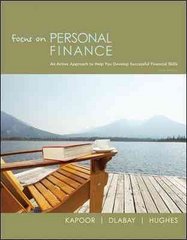Question
Question Two: (50 Marks) The financial report of a listed corporation in Hong Kong shows the following accounting policies in respect to the valuation of
Question Two: (50 Marks) The financial report of a listed corporation in Hong Kong shows the following accounting policies in respect to the valuation of its asset items in the financial accounts: Goodwill Goodwill on acquisition of subsidiaries or business is measured initially at cost, being the excess of the aggregate of the consideration transferred, the amount of any non controlling interest in the acquiree and any fair value of the Groups previously held equity interest in the acquiree over the fair value of the acquirees net identifiable assets acquired and liabilities assumed as at the acquisition date. After initial recognition, goodwill is measured at cost less any accumulated impairment losses. Goodwill is subject to impairment test annually and when there is indication that the carrying value may not be recoverable. If the fair value of the net assets acquired is in excess of the aggregate consideration transferred, the gain is recognized directly in the consolidated income statement. Goodwill on acquisition of associates and joint ventures, being the excess of the cost of the acquisition over the Groups share of the fair value of the identifiable net assets acquired, is included in the carrying amount of the investments in associates and joint ventures respectively and is not tested for impairment separately. On disposal of a subsidiary, associate or joint venture, the carrying amount of goodwill attributable to the entity sold is included in the calculation of the profit or loss on disposal. Investment properties Investment properties are land and buildings (including leasehold property interests owned or held as a right of use asset) held for long term rental yields or capital appreciation or both, and are not occupied by the Group. These include completed properties, those under construction and properties that are being redeveloped for continuing use as investment properties. Investment properties are measured initially at cost including transaction costs, and subsequently at fair value. Fair value is based on market value, as determined by independent qualified valuers at each reporting date on the highest and best use basis, and separate values are not attributed to land and buildings. The difference between the fair value of an investment property at the reporting date and its carrying amount prior to re measurement is included in the income statement as a valuation surplus or deficit. Costs incurred subsequently to develop, refurbish or replace part of an investment property are recognized in the assets carrying amount prior to fair value re assessment only when it is probable that future economic benefits associated with the cost item will flow to the Group and the cost can be measured reliably. All other repair and maintenance expenditures in respect of an investment property are expensed in profit or loss as incurred. An investment property is derecognized upon disposal or when the investment property is permanently withdrawn from use or no future economic benefits are expected to arise from its disposal. Property, plant and equipment Properties held for own use and other items of plant and equipment, including right of use assets arising from leases of underlying property, plant and equipment, are stated at cost less accumulated depreciation and impairment losses. The cost of an item of property, plant and equipment comprises its purchase price and any directly attributable costs of bringing the asset to its working condition and location for its intended use. The cost of self constructed items of property, plant and equipment comprises the direct costs of construction and capitalized borrowing costs on related borrowed funds during the period of construction. Gains or losses arising from the retirement or disposal of an item of property, plant and equipment are determined as the difference between the net disposal proceeds and the carrying amount of the item and are recognized in profit or loss on the date of retirement or disposal. Inventories Inventories comprising mainly building materials, hotel stocks, handsets and consumable goods are stated at the lower of cost and net realizable value. Cost is calculated on the weighted average basis. Net realizable value is the estimated selling price in the ordinary course of business, less applicable variable selling expenses Concession assets The Group has entered into a service concession arrangement with the Government of Hong Kong Special Administrative Region (HKSAR Government) to participate in the development, financing, operation and maintenance of toll road infrastructures. Under the arrangement, the Group carries out the construction of toll road for the granting authority and receives in exchange a right to operate the toll road and the entitlement to toll fees collected from users of the toll road. The assets including the cost of tunnel, approach road and buildings, electrical and mechanical systems under the service concession arrangement are recorded as intangible assets. Once the underlying infrastructure of the concession arrangement is completed, the concession assets are amortized over the term of the concession on a straight-line basis.
You are required to:
A. Discuss the various asset valuation approach (method) of each category of assets of this listed corporation as stated in its principle accounting policies in above. (30 marks)
B. Pick any one of the asset items shown above. Discuss and analyse why this item would better be presented under a separate valuation method for the true and fair view purpose. (20 marks)
Step by Step Solution
There are 3 Steps involved in it
Step: 1

Get Instant Access to Expert-Tailored Solutions
See step-by-step solutions with expert insights and AI powered tools for academic success
Step: 2

Step: 3

Ace Your Homework with AI
Get the answers you need in no time with our AI-driven, step-by-step assistance
Get Started


